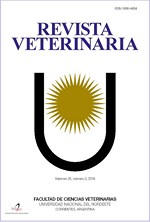Efecto del tratamiento J-Synch sobre el porcentaje de preñez en vaquillonas para cría inseminadas a tiempo fijo
DOI:
https://doi.org/10.30972/vet.3024131Palavras-chave:
Vaquillonas, tratamiento J-Synch, inseminación IATF, preñezResumo
El objetivo del trabajo fue evaluar el efecto del J-Synch en vaquillonas para cría sobre el porcentaje de preñez post inseminación artificial a tiempo fijo (IATF). Se utilizaron 613 vaquillonas Angus (edad: 13,5 a 15 meses; condición corporal: 3 a 3,5 - escala 1 a 5 (1: emaciada, 5: obesa) y peso: ≥ 260 kg). Los animales fueron asignados aleatoriamente a 3 grupos de unidades experimentales (diseño completamente aleatorizado): 1) J-Synch (n=205): el día 0 se colocó un dispositivo intravaginal con 0,6 g de progesterona (DISP) más 2 mg de benzoato de estradiol (BE). El día 6 se retiró el DISP y se administró 0,15 mg de d-cloprostenol. El día 9 (70-72 h post retiro del DISP), se inyectó 0,10 mg de buserelina y se realizó IATF. 2) Convencional 7D (n=206): el día 0 se colocó un DISP más 2 mg de BE. El día 7 se retiró el DISP y se administraron 0,15 mg de d-cloprostenol y 0,5 mg de cipionato de estradiol. El día 9 (50-52 h post DISP) se realizó IATF. 3) Convencional 8D (n=202): ídem grupo Convencional 7D, con la salvedad que el DISP permaneció colocado durante 8 días. Para la IATF se utilizó semen congelado/descongelado proveniente de un toro de probada fertilidad. El diagnóstico de gestación se realizó a los 30 días post IATF. El análisis estadístico se realizó por SAS (nivel de confianza: 95%). Los animales que perdieron el dispositivo fueron excluidos del análisis. El 3,4% de las vaquillonas perdieron el DISP. El porcentaje de preñez no difirió entre tratamientos (J-Synch: 50,8%; Convencional 7D: 43,4% y Convencional 8D: 47,7%, p>0,05). Se concluye que el tratamiento J-Synch utilizado en vaquillonas para cría (13,5-15 meses de edad) genera porcentajes de preñez post IATF similares al tratamiento convencional.
Downloads
Downloads
Publicado
Como Citar
Edição
Seção
Licença
Copyright (c) 2019 O. Dominicis, S. Madero, R. Catalano, J. Cabodevila, S. Callejas

Este trabalho está licenciado sob uma licença Creative Commons Attribution-NonCommercial 4.0 International License.
Política de acceso abierto
Esta revista proporciona un acceso abierto inmediato a su contenido, basado en el principio de que ofrecer al público un acceso libre a las investigaciones ayuda a un mayor intercambio global de conocimiento. La publicación por parte de terceros será autorizada por Revista Veterinaria toda vez que se la reconozca debidamente y en forma explícita como lugar de publicación del original.
Esta obra está bajo una licencia de Creative Commons Reconocimiento-NoComercial 4.0 Internacional (CC BY-NC 4.0)










.jpg)
.jpg)



